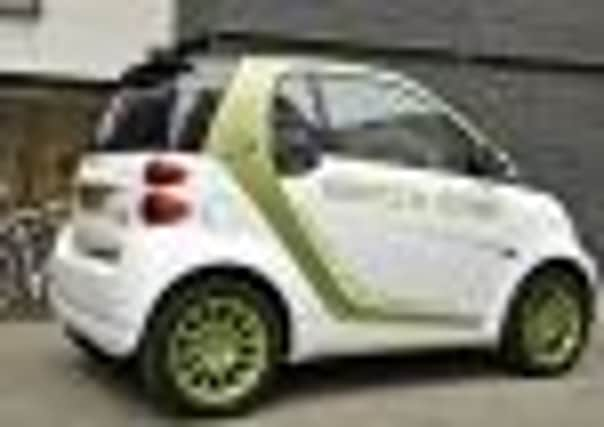Road test: Smart heralds the charge of the light brigade


Setting off in an unfamiliar electric vehicle for the first time can be disconcerting. You know it’s an electric car, but because of the absence of engine noise, that first silent surge forward when you dab the accelerator pedal can be unnerving. Launching off from the Smart of Edinburgh dealership, straight on to the Newbridge roundabout, then sweeping headlong into the bun fight that is the M9 at rush hour can be mildly unsettling in any car.
In a car this small, with almost non-existent acceleration at around the 50mph mark, and with the wind buffeting its tiny frame, driving along a Scottish motorway certainly isn’t the most enjoyable way to spend your time. In fact, only a complete idiot would begin a review of this car talking about its prowess on the open road.
Advertisement
Hide AdAdvertisement
Hide AdBut even this idiot can testify to the brilliance of the Fortwo Electric Drive (ED) once you get into the city. The obvious size advantages offered by a Smart car allow for some exceedingly naughty lane-changing, queue-jumping and unorthodox parking maneouvres, while the instantaneous, unstallable power available from an electric motor gives you a vital edge at the traffic lights. If most of your driving is urban, you don’t necessarily need a good 0-60mph time to get ahead – it’s the lower half of that scale that makes all the difference. The second-generation ED I drove manages 0-37mph in around 6.5 seconds, and the zero-to-cutting-in-front-of-that-BMW-at-the-lights dash is very satisfying indeed.
That will be bettered when the third-generation ED is launched later this year. With a more powerful battery (55kW maximum compared to 30kW maximum) and a higher top speed (74mph compared to 62mph), it will be able to hit 37mph in five seconds. Another advantage the third-generation will offer will be the fact you can actually buy it. There are only a couple of thousand second-generation EDs around, but the third-generation will see the car move into mass production and go on sale to the general public.
Range-wise, the forthcoming ED will squeak out three more miles than the current 83. But rather than display how many miles you have left, in true back-to-basics Smart style, your remaining charge is displayed on a pleasing analogue dial sprouting out of the dash. In some ways, this is preferarable to other electric vehicles’ “miles left” displays, which can cause panic attacks when they suddenly shave off 15 miles after you’ve switched the wipers on. There’s no such rug-pulling with this readout.
So who’s likely to buy one, aside from eco-conscious business fleet managers? People with their own garage or driveway, for a start – while there is a three-hours-for-80-per-cent-charge option, a full charge on a regular household plug takes eight hours and, what with the nanny state and all that, it probably breaks some law or other to string a live electrical cable out of your flat window out onto the road below – back off, Brussels!
Anyone who commutes more than 40 miles to work is probably out – unless they enjoy the adrenaline surge that comes with that “oh-God-have-I-got-enough-charge-to-get-home?” feeling. But anyone who does a fair bit of city driving and is fairly confident they won’t be called on to help transport a friend’s piano or visit an aunt in Birmingham should seriously consider this.
While it’s likely to be priced in the £20,000 region, at £2 per full charge, and 2p a mile to run, the chances are you’ll be getting silently cut up at the lights in a city near you soon.